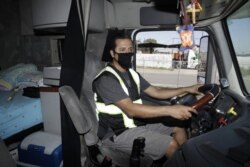It is becoming clear that the coronavirus crisis has had a major effect on the people working on the front lines.
They have been collecting and transporting supplies, caring for sick and older people, and keeping streets and buildings clean. They have watched their co-workers get sick. Thousands have gotten sick themselves. Many have died.
Front-line workers in the United States are mostly women and people of color, and are more likely to be immigrants. Workers who have been declared “essential” during the crisis are also more likely than the general population to live at or below the federal poverty line.
That information comes from a recent report by The Associated Press, or AP. AP reporters looked at population data from the country’s 100 largest cities.
“What is important about this pandemic is that it has shined a spotlight on workers who have always been essential but before this were invisible,” said David Michaels. He is a professor of environmental and occupational health at the Milken Institute School of Public Health at George Washington University.
Born homeless in New York City, Courtenay Brown is no stranger to life’s struggles. She and one of her sisters both work at an Amazon Fresh storage center in New Jersey. They live together in the city of Newark.
In most major cities, more than 60 percent of storage business and delivery workers are people of color. In Newark, that number is over 95 percent. Brown is among them.
When the pandemic began, Brown worked extra hours at her job as a supervisor to get the $2 hourly pay increase. Soon, several of her co-workers became infected. Others, she said, did not come into work at all.
One day, Brown felt very tired and in pain from a tendon condition. She did not feel like going into work. So, she stayed home. That morning, her phone rang over and over. She threw it across the room.
“I thought, ‘This just isn’t worth it,’” she told the AP.
Of the many kinds of front-line workers in America, food store employees are among the most visible.
Jane St. Louis works at a Safeway food store in Damascus, Maryland. She has worked there for 27 years, and knows many store customers. Some have brought her sweet treats during the pandemic. But other customers have not been so nice. One woman shouted at her for not wearing protective coverings on her hands.
Nationally, at least 16 percent of food store employees are estimated to live below the federal poverty line. Fifteen percent lack health care insurance.
The virus has killed at least 30 members of the United Food and Commercial Workers International Union, which represents 900,000 people. Another 3,000 have either gotten sick or been told to stay at home, the workers’ rights group says.
When St. Louis gets home, she removes her shoes and changes clothing. She cleans her shoes with special chemicals. Her work clothes immediately go in the washing machine, and she washes her body.
She does not want to risk infecting her husband or her 15-year-old granddaughter, who lives with the couple.
“I didn’t know I had anxiety until this started,” St. Louis said.
Juan Giraldo and his wife nearly lost their home after he lost his job during the 2008 financial crisis. A refinancing deal saved them from losing their home. But they were left deep in debt.
Giraldo, who is based in Los Angeles, California, drives a truck for a living. He has seen his work hours reduce as imports slow. He gets fewer than four deliveries a week, compared with at least 12 in normal times. He used to make $3,500 a month. Now, he is earning about $1,500.
More than 85 percent of warehouse and delivery workers in the Los Angeles area are people of color and 53 percent are foreign-born.
Giraldo was raised in Colombia by his grandparents after his father left the war-torn country to find work in California.
Giraldo did the same in his early 20s. As a contract worker, the father of four gets no paid sick leave and depends on California’s state health insurance program.
“They are calling us heroes,” Giraldo said, “but it’s like they are sending us to World War II with wooden pistols.”
I’m Pete Musto.
The Associated Press reported on this story. Pete Mustpo adapted it story for VOA Learning English. Ashley Thompson was the editor. We want to hear from you. Write to us in the Comments Section.
_______________________________________________________________
Words in This Story
front line(s) – n. the most important and active position in a job or field of activity
essential – adj. extremely important and necessary
pandemic – n.an occurrence in which a disease spreads very quickly and affects a large number of people over a wide area or throughout the world
invisible – adj. impossible to see
delivery – n. the act of taking something to a person or place
tendon – n. a tough piece of tissue in your body that connects a muscle to a bone
customer(s) – n. someone who buys goods or services from a business
insurance – n. an agreement in which a person makes regular payments to a company and the company promises to pay money if the person is injured or dies, or to pay money equal to the value of something (such as a house or car) if it is damaged, lost, or stolen
quarantine(d) – v. to keep (a person or animal) away from others to prevent a disease from spreading
anxiety – n. fear or nervousness about what might happen
pistol(s) – n. a small gun made to be aimed and fired with one hand











